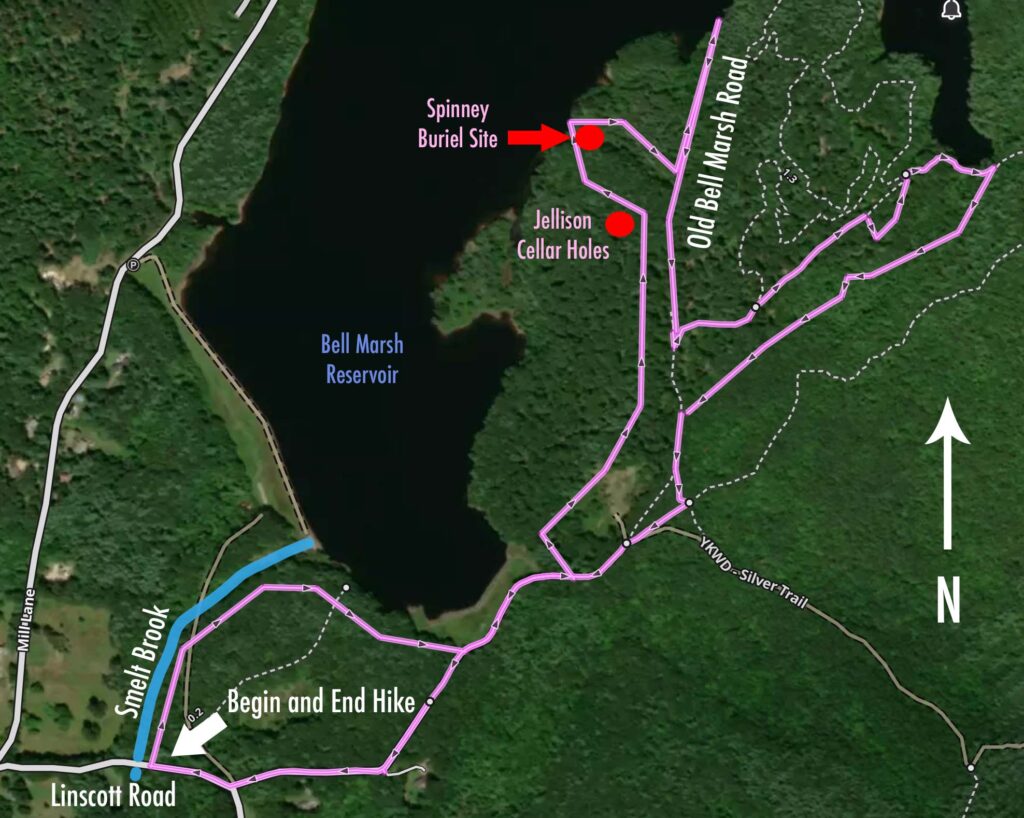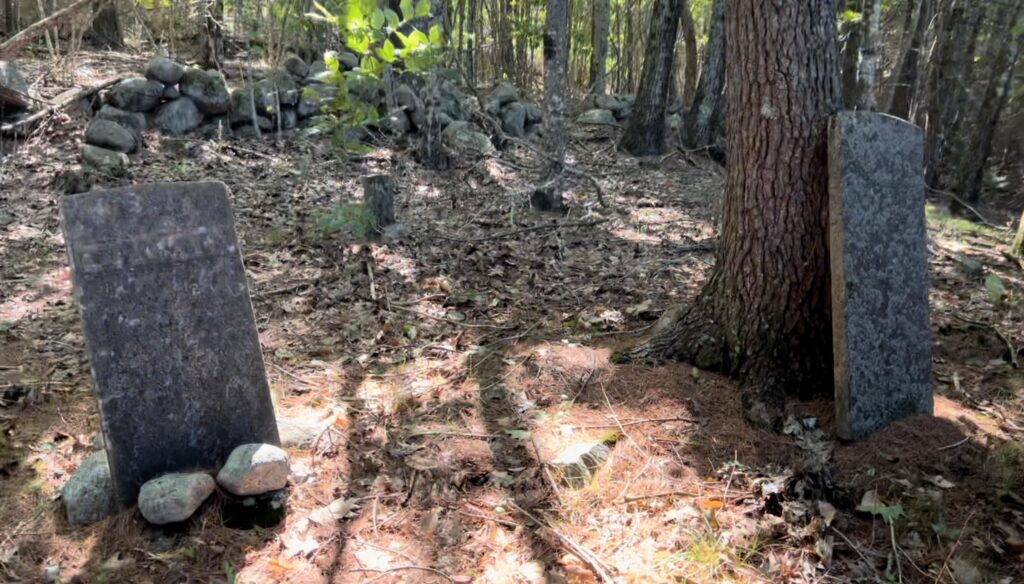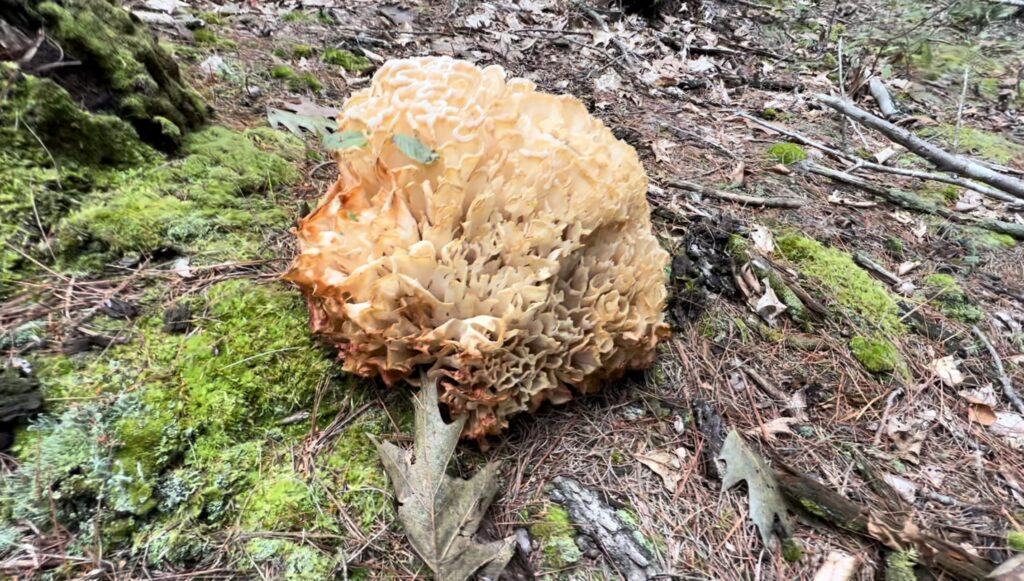Friday, September 23, 2022
by Kevin Freeman

A perfect fall day! Temps in the low to mid 60’sF. A thermal shirt below a long sleeved shirt, a fleece vest and fall was comfortable. I packed a peanut butter and raspberry jam sandwich and drove up to the intersection of Linscott Road and Mill Lane in York, Maine. In a few minutes after I arrived, Ron Nowell rolled up in his Ford pick up and I followed him to Smelt Brook on Linscott Road. We pulled over near the old dam site that was built by Ron’s 7th great-grandfather, Peter Nowell. Although I have lived in York my entire life I have never been down this road, from this direction, and had no idea of how ambitious the mill site before me was.
As we approached the mill Ron and I admired the huge hewn stones stacked high upon each other, presumably to support a large but long gone mill building. Peter Nowell1 arrived in York in 1694 and by all indications got right to work. He was a blacksmith, carpenter and soldier sent to the frontier of York soon after the 1692 Raid. He helped work on garrisons and built a house on Cider Hill Road. He sold the house and moved to Linscott Road, very close to Mill Lane. Today, the house appears to have been renovated and modernized.
Ron and I proceeded up Smelt Brook in the direction of Bell Marsh Reservoir. We were looking for small cellar holes that Ron believed to be near the mill. They were the home of his ancestors Silas Nowell and Shadrach Nowell. We continued up Smelt Brook without seeing what we imagined to be small holes in the ground or depressions where a root cellar had filled with twiggy litter. Peter Nowell2, Jr., mentions in his will a house he bequeathed to Shadrach that is about 4 rods north of the pole bridge that is where the culvert now passes beneath Linscott Road. We keep moving up the hill, through the woods and come to a chain link fence with barb wire on top. We walk along the fence and connect to Old Bell Marsh Road. It is not exactly clear how we found it but referring to the map on my phone we were on course and our direction should take us to the water’s edge in about a half mile.

On Wednesday, two days before today, Ron called me with preliminary plans of the area he would like to cover. Included was “Timothy Field” and the Chas. Jellison cellar hole, both, according to our best guess are to the west of Old Bell Marsh Road. Often, on these walks, if we find a cellar hole, we find a gravesite or visa versa. Weather wise, today has been magnificent — the bright fall light was especially warm and saturated with color, the weather was cool and perfect for a long walk. But it is especially difficult to scan the woods for un-natural features as the sunlight becomes mottled as it filters through the foliage. Although the effect is quite stunning the landscape is slightly obscured with harsh contrast and requires extra diligence in discerning possible points of interest. None-the-less we found the Jellison cellar hole by a stroke of luck. Something caught our eye and off the road and into the woods we went. In less than 100 feet, we recognized a foundation for a home and a larger one for a barn. Ron was pretty certain that there would be a gravesite nearby. We split up and Ron headed southwest to the Bell Marsh Reservoir and I walked westerly. After 10 minutes or so, I could hear Ron exclaiming something through the trees. I walked toward his voice and sure enough he had come upon a gravesite. Initially we thought it must be a Jellison gravesite but realized it was the Spinney gravesite listed on the Town of York Cemetery Map as #6. There were two large stones with very eroded inscriptions. These stones were likely sandstone. We could make out Abigail on one but nothing on the second stone. Also, there were 5 or six other graves with nondescript field stone headstones and footstones. We were very close to the reservoir, maybe 100 feet.
As we walked away from the burial ground, through the pathless forest toward Old Bell Marsh Road, I felt a connection to the souls represented by the nondescript stones, if only as a witness to their existence here on earth. Likely a family, a generation or two, existed way out here, laid to rest in a line with no other story to tell. As we walked, Ron and I exchanged stories of our personal lives. I noticed we talked about life’s difficulties, oddities, concerns and celebrations — the kinds of things that I would share with a friend. For years, Ron has been an acquaintance that I have admired and enjoyed listening to. His vast knowledge of many topics has intrigued me. But now, as we were walking to the point where Old Bell Marsh Road submerges below the surface of the water and disappears, reemerging on the opposite shore, I listen closely to our conversation thinking it likely that those who lived and died here once conversed similarly, as Ron and me, walking this road in an exchange of thoughts, like us — an endless recurrence by humans, all the way back to the beginning.
We walked to the point of where the road disappears into the water and then back tracked a bit. We turn east from Old Bell Marsh Road and ascend what we think may be one of the Horse Hills. As our elevation increased so did my heart rate. Ron’s third destination today is Beaver Dam Brook. He is fixated on finding the source of a brook which he has found on a survey plan that shows a stone causeway. The causeway is currently submerged but intuition tells us that the source of the brook is at the far east side of the reservoir. As we walk, I spot a soccer ball sized mushroom off in the distance. Wow, as an avid forager, I have never seen anything like this in the forest. We walk toward it, not certain it is a mushroom. At first it looks like a chicken of the woods but upon closer inspection it becomes a cauliflower mushroom (sparassis). I reach into and pull from my backpack a hunting knife. I slice away a small section of the mushroom and put it in my pack along with the knife. I am quite thrilled to add a new species to my expanding list of things foraged. Ron deliberated on taking a piece but decided not to. We ate our sandwiches, enjoyed warm coffee from our thermoses and basked in the fall sunlight. The woods were radiant and saturated with water from the recent rains after a long dry summer.

When we did proceed we kept moving easterly and arrived at a brook that Ron declared was Beaver Dam Brook. We were at the very southeastern point of the reservoir. The forest was comprised of many large hemlocks and pines. The hemlocks were in various states of decline. The brook went upward and we were both eager to follow it to the top and discover what may be. As we neared the top Ron asked our elevation. I looked at the map app on my phone and reported 207 feet above sea level. We arrived at a very large wetland on top of the hill. It was truly a wonderland. Carpeted by sphagnum moss we were enveloped by a primal ecosystem that was decorated with fall ferns — loosing their chlorophyll and turning various shades of yellow and gold. Above, there were large white maples trunks in various stages of decay and below pitcher plants and numerous bushes that provided a challenge to make one’s way through. We pushed through and then around, both giddy with what we discovered. But we realized we did not discover this after all. On one of the footpaths we crossed I noticed a long slender stone spanning the book. I jokingly said to Ron, this could the stone causeway referenced on the survey plan. He leaned over to discover drill marks along the edge of the stone. Sure enough, it was cut and placed to serve as a causeway by someone who had been here long before us.

As we begin the hike back, to where we began, I reflect on all that I have just experienced. Ron fills in the spaces with numerous stories of mutual friends and acquaintances, stories of his his time on the Board of Selectman and as a gunner in Vietnam. As we get closer to Linscott Road, Ron reaches down on the gravel road and picks up some shagbark hickory nuts. Many have been split by squirrels but there are so many others he gathers some to take home. He tells me of his grandmother making cinnamon buns using the hickory nuts as a garnish and how sweet they are. I begin to fill up a pocket as well. Cars and trucks begin to pass us on the old gravel road as we get closer to the mill site where we parked. We both instinctively walk over to the mill site. Ron sits on one of the huge hewn stones and reflects on Peter Nowell, Shadrach, Silas and others. We exchange questions with each other…how did they move these huge stones? What did they do with all the material they created? Where did it all end up? It became apparent that much would be unanswered for today although much was learned. I suggest to Ron that it would be appropriate to commemorate the Nowell Mill site with a plaque to recognize its historical value.
Reference: The Nowells of York and South Berwick, Maine by John E. Frost

Beautifully written commentary about a place very close to my heart ( my ancestors lived here ) and Im eager to share the photos I have. Kevin and Ron, we are so grateful for the care and thoughtful approach to those who came before us.
Hi Nancy, Thanks for your nice comment! I feel very fortunate to have Ron as a guide. Looking forward to seeing your photos. Kevin
I came across a list of William Samuel Kingsbury and Lydia Nowell’s children ( looks to have been 10 in all ). One of them was my great,great grandfather, Rufus Kingsbury who lived in the house at the top of Kingsbury Lane off Rte. 91. I mention the location because it’s quite likely why my grandmother Adeline Wilson had the small photo album that includes the face of William and his wife Lydia. (She lived part of her life in that same house where Selwyn Sikberblatt lived ) The other photos are likely to be of the offspring of the list of 10. Due to the similarities in their faces most are Kingsburys. // Thanks again for this inspiring piece, Kevin.
Is your grandmother’s photo album unaccounted for?